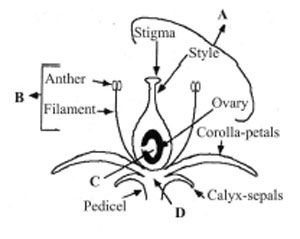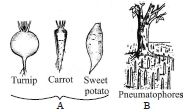The given figure shows a typical structure of monocotyledonous seeds. Identify A, B, C, D and E parts marked in the given figures.

A - Endosperm, B - Embryo, C - Scutellum, D - Coleorhiza, E - Coleoptile
A- Embryo, B - Endosperm, C - Scutellum, D - Coleoptile, E - Coleorhiza
A - Endosperm, B - Embryo, C - Scutellum, D - Coleoptile, E - Coleorhiza
A - Embryo, B - Endosperm, C - Scutellum, D - Coleorhiza, E - Coleoptile
Correct Answer :
C. A - Endosperm, B - Embryo, C - Scutellum, D - Coleoptile, E - Coleorhiza
In the given figure of monocotyledonous seeds, the structure marked as A, B, C, D and E are respectively endosperm, embryo, scutellum, coleoptile and coleorhiza. Endosperm is the part of a seed which acts as a food store for the developing plant embryo, usually containing starch with protein and other nutrients. Embryo is the part of a seed which develops into a plant, consisting (in the mature embryo of a higher plant) of a plumule, a radicle, and one or two cotyledons. Scutellum is the large shield like cotyledon of the embryo of certain monocots. It is specialized for the absorption of food from the endosperm. Coleoptile is the first leaf above the ground, forming a protective sheath around the stem tip. It surrounds the plumule. Coleorhiza is the sheath that envelops the radicle in certain plants and that is penetrated by the root in germination.
Related Questions
Which one of the following statement is correct?
Bulb of Allium cepa is a modified stem.
Cloves of Allium sativum are fleshy scale leaves.
Corm of Colocasia is a modified root.
Tendril in Vitis vinifera is a modified axillary bud.
Study the following statements and select the correct option
- Buds are present in axil of leaflets of the compound leaf.
- Pulvinus leaf-base is present in some leguminous plants.
- In Alstonia, the petioles expand, become green and synthesize food.
- Opposite phyllotaxy is seen in guava.
(ii) and (iv) are correct but (i) and (iii) are incorrect.
(i) and (iii) are correct but (ii) and (iv) are incorrect.
(i) and (iv) are correct but (ii) and (iii) are incorrect.
(ii), (iii) and (iv) are correct but (i) is incorrect.
Which of the following statements are correct?
- From the region of elongation, some of the epidermal cells form root hairs.
- Pneumatophores are seen in Rhizophora.
- Adventitious roots are seen in the banyan tree.
- Maize and sugarcane have prop roots.
(i) and (iv)
(i), (iii) and (iv)
(iii) and (iv)
(ii) and (iii)
Aleurone layer helps in
storage of food in endosperm.
protection of embryo.
utilization of stored food.
all of the above.
The region of the stem where leaves are born are called ____________ while ____________ are the portions between two ____________.
nodes, nodes and internodes
nodes, internodes and nodes
internodes, nodes and nodes
internodes, internodes and nodes
A - Which one of the option shows the correct labelling of the parts marked as A, B, C and D in a typical structure of dicotyledonous seeds ?

A - Hilum, B - Micropyle, C - Radicle, D - Cotyledon, E - Plumule
A - Hilum, B - Micropyle, C - Plumule, D - Cotyledon, E - Radicle
A - Micropyle, B - Hilum, C - Plumule, D - Cotyledon, E - Radicle
A - Hilum, B - Micropyle, C - Plumule, D - Radicle, E - Cotyledon
Fibrous root system is found in
monocotyledonous plants.
dicotyledonous plants.
bryophytes.
gymnosperms.
The given figure shows the parts of mango and coconut. Choose the option which shows the correct labelling of A, B, C and D marked in the figures.

A - Epicarp, B - Mesocarp, C - Seed, D - Endocarp
A - Epicarp, B - Mesocarp, C - Ovule, D - Endocarp
A - Epicarp, B - Mesocarp, C - Ovary, D - Endocarp
A - Epicarp, B - Mesocarp, C - Embryo, D - Endocarp
Consider the following statements regarding the root system of angiosperms and choose the correct option given below.
- In monocots, the fibrous root system arises from the base of the stem.
- The region of elongation is called the root hair region.
- In sweet potato, the adventitious roots get swollen and store food.
- The stems of maize and sugarcane have supporting roots called prop roots.
(i) and (ii) are correct but (iii) and (iv) are wrong.
(ii) and (iii) are correct but (i) and (iv) are wrong.
(ii) and (iv) are correct but (i) and (iii) are wrong.
(i) and (iii) are correct but (ii) and (iv) are wrong.
Which of the following is the green expanded part of leaf with vein and veinlets?
Petiole
Node
Stipule
Lamina
Which one of the following option shows the correct labelling of the structure marked as A, B, C & D?

A - Gynoecium, B - Megasporophyll, C - Ovule, D - Thalamus
A - Gynoecium, B - Stamen, C - Seed, D - Thalamus
A - Microsporophyll, B - Stamen, C - Ovule, D - Thalamus
A - Gynoecium, B - Stamen, C - Ovule, D - Thalamus
Which of the following statement(s) is/are correct about calyx?
Calyx is the outermost whorl of the flower and are called sepals.
Sepals are green, leaf like and protect the flower in the bud stage.
The calyx may be gamosepalous (sepals free) or polysepalous (sepals united).
Both (a) and (b)
Alternate type of phyllotaxy is found in
china rose
mustard
sunflower
all of these
Which of the following plants is growing in swampy areas, where many roots come out of the ground and grow vertically upwards?
Potato
Opuntia
Rhizophora
Grass
The given figure shows a typical structure of monocotyledonous seeds. Identify A, B, C, D and E parts marked in the given figures.

A - Endosperm, B - Embryo, C - Scutellum, D - Coleorhiza, E - Coleoptile
A- Embryo, B - Endosperm, C - Scutellum, D - Coleoptile, E - Coleorhiza
A - Endosperm, B - Embryo, C - Scutellum, D - Coleoptile, E - Coleorhiza
A - Embryo, B - Endosperm, C - Scutellum, D - Coleorhiza, E - Coleoptile
Identify the kind of phyllotaxy shown in the given figures A, B, and C.

A-Alternate, B - Opposite, C - Whorled
A- Whorled, B - Opposite, C -Alternate
A-Alternate, B - Whorled, C - Opposite
A-Whorled, B -Alternate, C - Opposite
The flower is the reproductive unit in the ___________ meant for ___________ reproduction.
angiosperms and sexual
gymnosperms and sexual
algae and asexual
pteridophytes and asexual
The mature seeds of plants such as gram and peas, possess no endosperm, because
these plants are not angiosperms.
there is no double fertilization in them.
endosperm is not formed in them.
endosperm gets used up by the developing embryo during seed development.
The given figure (A, B, and C) shows different types of roots. Identify the root which is seen in wheat plant and originate from the base of the stem?

A
B
C
Both A and B
Prop roots of banyan tree are meant for
respiration.
absorption of water from soil.
providing support to big tree.
all of the above.
The given figures (A and B) shows the modificaiton of roots.Which of the following statements regarding the figures is correct ?

Tap roots of carrot, turnip and adventitious root of sweet potato, get swollen and store food.
Pneumatophores conducts water, minerals & photosynthesis
Pneumatophore is found in the plants that grow in sandy soil.
Turnip & carrot shows adventitious roots and sweet potato shows tap root.
The main function(s) of root system is/are
absorption of water and minerals from the soil
storing reserve food material
synthesis of plant growth regulators
All of the above
Which one of the following statement is not correct?
Each stamen which represents the male reproductive organ consists of a stalk or a filament and an anther.
An actinomorphic flower can be dissected into two equal halves from any plane.
Superior ovary is found in hypogynous flowers.
When stamens are attached to the petals, they are epiphyllous as in brinjal.
The part of the root which is most active in water absorption is called
root cap
maturation zone
meristematic zone
zone of elongation
Which one of the following characteristics does not belong to parietal placentation?
Ovules are borne on central axis.
Ovary is one-chambered but it becomes two-chambered due to the formation of false septum.
Examples are mustard and Argemone.
Both (b) and (c)
Root hairs develop from
region of maturation
region of elongation
region of meristematic activity
root cap
Which type of function is performed by the fleshy leaves of onion and garlic?
Storage
Reproduction
Photosynthesis
Protection
When a flower can be divided into two equal radial halves in any radial plane passing through the centre, it is known as
actinomorphic
zygomorphic
asymmetric
bisymmetric
How many plants in the list given below have marginal placentation?
- Mustard
- Gram
- Tulip
- Asparagus
- Arhar
- Sunhemp
- Chilli
- Colchicine
- Onion
- Moong
- Pea
- Tobacco
- Lupin
Four
Five
Six
Three
Main function of leaf is
exchange of gases
increase the beauty of a tree
manufacturing of food
nerve impulse induction
